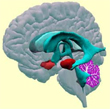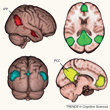Tuesday, 27 January 2015
Functions of the amygdala : more diverse than previously thought

Science in general, and neuroscience in particular, are constantly evolving. So even though our knowledge of a given brain structure may not have undergone a scientific revolution or a paradigm shift at any given time, when we compare what we know about it now with what we knew, say, 10 years ago, we may find that things have changed a lot. That’s certainly the case for the amygdala, a small but very important piece of the brain. And since we first described the amygdala on this website just about 10 years ago, we’d like to give you a little update now. (more…)
Emotions and the Brain | Comments Closed
Tuesday, 6 January 2015
Literary Activity and the Default Mode Network

In every human culture, much of life revolves around the stories that we tell—about the world around us, about other people, and about ourselves. When you come right down to it, just like traditional oral storytelling, that is all that modern literature and film do today. There must be something in the brain that resonates especially strongly with the narrative process.
That something might well resemble what neuroscientists call the the brain’s default mode network: the particular set of brain structures whose activity increases by default, when someone is doing absolutely nothing. (more…)
From Thought to Language | Comments Closed







